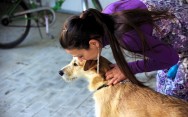Blog Archives
Home -
Archive by category "Animal rights" (Page 11)
When mainstream publications like Fortune.com start publishing articles arguing for a meat tax, you know that something is in the air. Sweden, Denmark and Germany are calling for a meat tax. The American Institute for Cancer Research and the American College of Cardiology are in favor. The environmental costs of methane and soil erosion from the cattle industry are well known. Meanwhile, people are waking up to the horrible conditions that animals suffer in factory farms. The article also points out how much damage the meat industry does in its production phase even before animal products go into people’s bodies. Air and water pollution from meat production predominantly affects people unfortunate enough to live within range (usually lower income people, who are often people of color).
When we treat the environment, animals or other human beings as dehumanized products, there are always consequences for individual and collective wellbeing. Cruelty has been sold as self-interest when in fact it is quite the opposite – it undermines whole environmental systems and deprives us of our potential to peacefully co-exist with animals.
http://fortune.com/2018/02/20/meat-tax-climate-change-health-us/
“The reality is, it’s not illegal to kill your own animal in Canada. Someone can take a gun and shoot their dog in the head and as long as the dog dies instantly, unfortunately there’s no law against that.”
This telling quote is from Lori Chortyk, general manager of community relations for the BC SPCA, responding to outrage over the death of a pot-bellied pig who was killed and eaten by her owners less than one month after she was adopted from the BC SPCA where she was nursed back to health. Tragically, during the adoption and matching process, the couple who adopted the pig Molly even put in writing “No, I will never use this animal for food.” Yet, even after the process and an investigation, nothing could be done to hold the owners accountable for Molly’s death. The investigation determined that the pig didn’t die in a way that would be considered inhumane and would lead to animal cruelty charges.
One argument that is being made by people angry at Molly’s death is that this would never happen to cats or dogs. Pigs are intelligent animals that are unjustly treated. This still doesn’t quite reveal the extent of the problem though. The bottom line is articulated by Chortyk: “pets are considered property.” If your animal is considered an object you can do with the animal what you want with it, provided a line isn’t crossed that the law considers too far. The process of the BC SPCA is sadly lacking in its ability to do anything meaningful to protect animals because it’s not legally binding. Animal cruelty laws may protect animals from unnecessary cruelty, but they don’t protect them from the every-day cruelty of being treated as objects for human consumption.
Read more about this story here: https://globalnews.ca/news/4042125/pig-adopted-bc-spca-killed-eaten-owners/
At first glance, it looks typical of the Trump administration to flip-flop on lifting the Obama-era ban on big game and trophy imports. When you look closer at why this is happening though, you see a network of influences that are unfriendly to human and animal life and the environment. One of the most prominent of these is the NRA.
The Trump Administration is receiving criticism for their opaqueness about the ban. The Fish and Wildlife Service didn’t publically release a memo about rolling back the ban on trophy and game imports and are being vague about the criteria that will be used to review individual cases. In their rationale for lifting the ban the agency directly cited a DC Circuit Court ruling in a case brought by the NRA and the Safari Club International that attacked the Obama era ban on technicalities. In lifting the ban they’ve removed certain criteria for reviewing permits as far back as 1995, which will mean other animals — not just elephants, but lions and bonteboks from South Africa — will be vulnerable. A census of African Elephants says that their population had plummeted by roughly 30 percent from 2007 to 2014. Supporters of hunting say fees go to conservation, but activists are concerned that fees from big game hunting are siphoned into corruption. Even Trump himself has expressed skepticism about funds from hunting going back into conservation.
There aren’t many organizations who care less about life than the NRA. Their support of big game hunting shows how regard for human and animal life is intimately connected. When Trump’s own Secretary of the Interior Ryan Zinke supports lifting the ban, installs the “big buck hunter” videogame in his employee cafeteria and lifts a ban on lead bullets that poison animals, it’s clear that the administration is part of a more insidious problem. Violence is violence, and with every decision the Trump administration makes, it gives explicit and implicit support to organizations that are unfriendly to life on this planet.
Read more about this story here: https://www.npr.org/sections/thetwo-way/2018/03/06/591209422/trump-administration-quietly-decides-again-to-allow-elephant-trophy-imports
According to a viral video that sparked outrage on the internet, New York police killed a raccoon in the most inhumane way by running the animal over repeatedly with their vehicles. The woman who shared the videos reported that it took 15 minutes for the animal to die. The police have said they didn’t want to shoot the raccoon because it was in a populated area, and the animal is claimed to have been rabid.
For a death this painful and prolonged, we have scarce information to justify it. It is a persistent problem that police are allowed to respond to threats with less than adequate caution and respect for human and animal life. Animals’ lives are easily devalued in situations where they are seen as merely a “threat”, and officers can act violently without consequence. The Department of Environmental Conservation is reportedly investigating the death. We hope for answers…
https://www.cbsnews.com/news/video-coeymans-new-york-officers-running-over-raccoon/
How could a well-liked science teacher trusted and respected by his students, feed a puppy to a snapping turtle? Such is the cognitive dissonance of our attitude to animal cruelty. On the one hand the teacher is well-liked enough that he can gain 3,000 signatures in his support (a petition for his firing has many more signatures). On the other hand he thought nothing of the suffering of the puppy he allegedly fed to the snapping turtle. The way the incident has been handled similarly speaks volumes about how people disregard animals’ lives. The teacher’s snapping turtle has been euthanized since the incident, apparently because authorities couldn’t find a home for it. Because of human drama, two animals have lost their lives.
Neither the teacher’s treatment of the puppy or the authorities handling of the incident makes much sense in the context of their own values. A trusted and well-loved teacher who seems to have cared for his students didn’t think how his teaching methods could be cruel. Community authorities sacrificed a second animal in pursuit of “what’s right.” In both cases, the animals’ themselves didn’t seem to matter.
You can read more about this story, here: http://www.idahostatesman.com/news/local/article205430089.html
Recently, a science teacher in a junior high school in Preston, Idaho, threw a puppy into the mouth of a snapping turtle. The puppy’s screams could be heard all around the school but no one intervened. The teacher claims that the puppy was deformed and ill, implying that this justified the painful and harmful way he ended the puppy’s life. It is surprising that the teacher has not been immediately suspended.
Here is a URL for the animal cruelty statute of Idaho:
http://aldf.org/wp-content/uploads/2017/01/IDAHO16_FINAL.pdf
Here is the school handbook showing that the Superintendent is ultimately liable:
http://www.prestonidahoschools.org/uploads/8/3/6/9/8369288/psd_employee_handbook_2016-2017.pdf
After one year locked in a cell while his family battled to free him, a dog named Bandit was scheduled to be killed on March 2nd. The City of Aurora animal shelter kept the dog in a concrete cell, where it’s claimed he became depressed and put on weight. Meanwhile, his family fought against the city’s decision to kill him after an incident where a FedEx driver was hurt.
What’s heartbreaking is that his family were given less than 24 hours’ notice to say goodbye before he was due to be euthanized. This, after an emotionally draining year of fighting for their fourteenth amendment rights and proposing a number of non-violent solutions to rehabilitate and re-train Bandit. Yet still, the city chose to defend its position and kill the dog.
The issue keeping the city locked in a conflict that seems needlessly cruel to both owners and dog, is the dog’s breed. The dog was adopted by the owners as a boxer mix, but a test by the city (which an animal law expert has said is flawed) determined that the dog was 100 percent Staffordshire Terrier. Staffordshire Terriers are a type of “pit bull” dog, which are banned in Aurora. In a lawsuit brought by the family of the dog, they claimed their rights were violated as they were forced to plead in criminal proceedings that they were harboring a “dangerous dog.” They are originally from Russia and English is not their first language. As a result, they claimed they didn’t understand they would be forfeiting their dog’s life with the plea. The dog was surprised by a FedEx driver who backed off and received an alarmed snap from the dog. The driver was treated for injuries that apparently weren’t serious. It’s easy to see how a dog would react like this, but the city has chosen to remain hardline on the conclusion that his breed “caused” the attack.
Across the US and elsewhere pit bull bans are being challenged and research is increasingly demonstrating that breed doesn’t play a big role in animals’ threat to people. What the city of Aurora is clinging on to is prejudice and punishment, rather than law and order. Can such arbitrary violence, emotional heartache and wasted resources really be for the greater good? The city had plenty of options to work with the family on this and they didn’t. It remains to be seen if bad publicity and legal action will convince them that violence can only cause more violence.
Please see the following article for more details: http://www.westword.com/news/accused-pit-bull-bandit-to-be-put-to-death-in-aurora-colorado-10048715
Animal advocates recently drew attention to the death of a dog called Noah at the Devore Animal
Shelter. Noah was allegedly killed for having a broken leg, as part of the shelter’s new policy to kill
sick and injured animals without a grace period.
Although there are plenty of people who would rescue or even temporarily house a dog that is sick
or injured, that option is being swept away. The problem is that shelters are drastically overcrowded
and states don’t allocate funds to create No Kill shelters. The term “shelter” has therefore become
misleading for animal lovers who may not be aware that pets who have an injury don’t even have
time to be considered for a new home. A more targeted approach would be to fund a grace period
for animals like Noah, so that animal lovers and activists can mobilize to get the pet a good home
before they are killed. Without any attention on this issue at all though, “shelters” kill policies go unnoticed. Injured, disabled or sick animals like Noah lose their lives.
Many people are just not aware of this problem. You can help by spreading the word, organizing to
fund animal shelters and contacting your local representative about funding to save animal lives.
The suffering of a golden retriever who was horribly bludgeoned to death by Chinese police has caught the attention of the global internet recently. Two people reportedly had minor injuries after the dog bit them. The police officer wasn’t armed with a tranquilizer gun and claimed he was justified in protecting public safety when he beat the dog to death with a wooden club slowly over 3 hours, according to reports. PETA says the killing was witnessed by onlookers including young children. Video footage and pictures showing the death of the dog drew a huge outcry on social media. Reports describe the pain of the dog as it died. On the sidewalk where the dog was tied up, there is now a shrine with candles and flowers. The death of the golden retriever was portrayed by the Chinese police as a necessary evil to remove a threat to people. Rather than a humane killing though, witnesses and viewers of the images and video experienced it as extreme violence and trauma. This animal killing clearly shows how violence affects everyone it touches – and now that people have access to images and videos even thousands of miles away, it reaches even wider. The violence to the dog far outweighs any public threat, and if anything there’s a sense in which it has now done lasting emotional damage to anyone unfortunate enough to witness it. If there can be any positive impact from the death of this poor defenseless animal, it’s to send the message that violence like this is never necessary.
Please read the news and share:
http://metro.co.uk/2018/01/03/policeman-bludgeoned- golden-retriever- death-street- bit-two- people-7200934/
http://www.dailymail.co.uk/news/article-5228433/Golden- retriever-dies- beaten-policeman.html
Spirit Airlines has admitted that it gave confusing info to a woman flying from college to South Florida with her emotional support hamster. The airline told her it was OK to bring her hamster with
her on board the aircraft after she called several times in advance to check. However, when she
arrived in the airport, staff told her she couldn’t bring her hamster, Pebbles, on board, and allegedly
advised her to let the animal loose outside the airport or flush him down the toilet. With no option to
cancel the flight or give the hamster to a friend, the woman faced the terrible choice of letting her pet fend for itself outside, or ending the pet’s life. She chose the latter.
This is a story that will surely strike fear and sadness into the hearts of people traveling with
emotional support animals. In general, emotional support animals are allowed to travel by air. Of
course, people’s right to travel with these animals has to be balanced with considerations for the
safety of other passengers, and as emotional support animals aren’t trained there can be concerns
about other passengers. Because of this, unlike service animals, who are specially trained for
specific purposes, emotional support animals aren’t always allowed in public places. This leaves
animals like Pebbles vulnerable to harm where there are grey areas between federal law and an
airline’s policy. If an airline can’t make a determination about whether an animal can fly until the last minute, the animals could fall victim to the kind of tragic circumstances that befell Pebbles. Guidelines and policies need to be clearer to protect emotional support animals like Pebbles who are traveling with their owners.
Read more and share the news: http://www.miamiherald.com/news/local/community/miami-dade/article198971069.html








Social Media